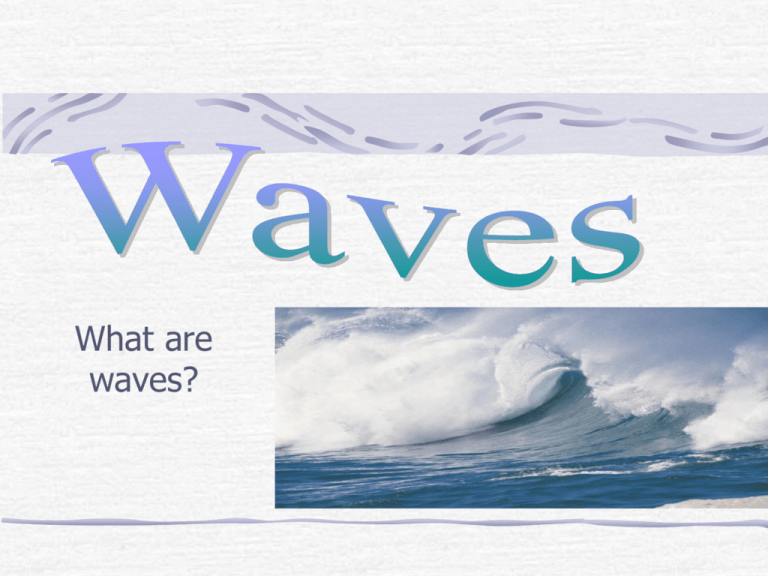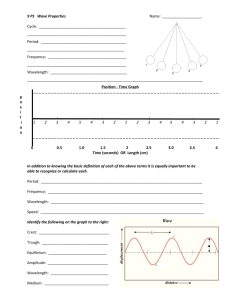Waves
advertisement

What are waves? Wave Definition: A disturbance that transfers energy from place to place. What carries waves? A medium, a medium is the material through which a wave travels. A medium can be a gas, liquid, or solid. Not all waves require a medium to travel. Light from the sun travels through empty space. What causes waves? Waves are created when a source of energy causes a medium to vibrate. A vibration is a repeated back and forth or up and down motion. Types of waves: Waves are classified according to how they move. Transverse wave Waves that move the medium at right angles to the direction in which the waves are traveling is called a transverse wave. Transverse means across.The highest parts are called crests the lowest parts are called troughs. Compressional Wave Matter vibrates in the same direction as the wave travels. Example: Slinky Compressional wave The parts,where the coils are close together are called compressions, the parts where the coils are spread out are called rarefactions. Combinations of waves Surface waves are a combination of transverse and longitudinal waves.The waves occur at the surface between water and air. Properties of Waves Basic Properties of Waves Amplitude Wavelength Frequency Speed Draw Transverse wave and label: crest & trough the old Slinky song) Draw a Compressional wave: label compression& rarefaction Amplitude Amplitude is the maximum distance the particles of the medium carrying the wave move away from their rest positions. The farther the medium moves as it vibrates the larger the amplitude of the resulting waves. The greater the amplitude the greater the amount of energy Amplitude of transverse waves The amplitude of a transverse wave is the maximum distance the medium moves up or down from its rest position. You can find the amplitude of a transverse wave by measuring the distance from rest to crest or rest to trough. Amplitude of a longitudinal wave. The amplitude of a longitudinal wave is a measure of how compressed or rarefied the medium becomes. Wavelength A wave travels a certain distance before it starts to repeat. The distance between two corresponding parts of a wave is its wavelength. Transverse measure from crest to crest or trough to trough. Longitudinal measure from one compression to the next. Frequency The number of complete waves that pass a given point in a certain amount of time. AKA number of vibrations per second. Frequency measured in hertz (Hz). Speed The speed, wavelength, and frequency of a wave are related to each other by a mathematical formula. Speed = wavelength x frequency Frequency = speed/wavelength Wavelength = speed/frequency Speed Waves in different mediums travel at different speeds. However, in a given medium and under the same conditions the speed of the wave is constant. Chapter 15 -3 Ways Waves Interact Reflection Refraction Diffraction Interference Constructive Destructive Standing Waves Reflection When an object or wave hits a surface through which it cannot pass, it bounces back. Angle of incidence Angle of reflection Examples of reflection Mirror Echo Ball against a wall Refraction is when a wave moves from one medium into another medium at an angle, it changes speed as it enters the second medium which causes it to bend. The bending of waves due to a change in speed is called refraction. Refraction Though all waves change speed when they enter a new medium. Bending occurs when one side of the wave enters the new medium before the other side Diffraction When a wave passes a barrier or moves through a hole in a barrier it bends and spreads out. Interference Constructive interference occurs whenever two waves combine to make a wave with a larger amplitude. Destructive interference when the amplitudes of two waves combine producing a smaller amplitude. Standing waves: If the incoming wave and the reflected wave combine at the right places the combined wave appears to be standing still. It appears to be standing in one place, even though it is two waves interfering as they pass through each other. Nodes and Antinodes Nodes: at certain points, destructive interference causes the two waves to combine and produce an amplitude of zero. Antinodes are the points of maximum energy. The crests and troughs of a standing wave. Resonance Most objects have a natural frequency of vibration. Resonance occurs when vibrations traveling through an object match the object’s natural frequency. An object that is vibrating at its natural frequency absorbs energy from the objects that vibrate at the same frequency. Occurs in music.








